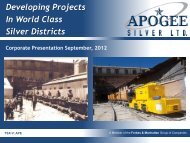Pulacayo Project Feasibility Study - Apogee Silver
Pulacayo Project Feasibility Study - Apogee Silver
Pulacayo Project Feasibility Study - Apogee Silver
Create successful ePaper yourself
Turn your PDF publications into a flip-book with our unique Google optimized e-Paper software.
<strong>Pulacayo</strong> 1 000 t/d Phase I <strong>Feasibility</strong> <strong>Study</strong> - NI 43-101 Technical Report<br />
090644-3-0000-20-IFI-100<br />
Patacayama for packaging before being onward shipped to China. However, if the concentrates<br />
need to be blended and suitable facilities do not exist in Bolivia, trucking to Callao, Peru where<br />
they will either be blended for export or shipped ‘as is’ in containers, again with destination China<br />
(or parity) may be an option. This movement may actually prove to be competitive based on<br />
estimated trucking, port costs and ocean freight rates and would offer a greater degree of<br />
commercial flexibility due to the number of traders operating out of this port.<br />
In addition to the various trucking alternatives, FCAB (owned by the Luksic Group in Chile)<br />
operates a rail line from which runs relatively near to the project to Antofagasta. Early indications<br />
were that rates for concentrate movements to the port may potentially be very low. However, it is<br />
understood that this line is already operating at capacity and may not be able to handle any<br />
additional concentrates.<br />
As noted earlier, any costs associated with these movements will either be borne directly by<br />
<strong>Pulacayo</strong> or be charged back to the mine via a freight allowance imposed by the buyer. In either<br />
case, the net cost is assumed to be the equivalent.<br />
19.5.2 Additional Logistics Issues<br />
19.5.2.1 Handling Losses<br />
During the transportation of concentrates from the mine to the customer, it is inevitable that some<br />
losses will occur due to spillage and exposure to the elements. While there is no exact figure as<br />
to what handling losses can be expected, common industry practice suggests losses of 0.1 to<br />
0.2% at each handling point. Based on the movement of concentrate from the mine to the<br />
receiving smelter the handling points would be as follows:<br />
1. Storage shed at mine loaded into truck<br />
2. Truck discharged into storage shed at port<br />
3. Storage shed at port conveyed into container/onto vessel<br />
4. Vessel discharged onto quay/into trucks<br />
Depending on the handling procedures prior to weighing and sampling at the receiving end, there<br />
could be an additional handling point (or points) after discharge. Based on the above noted rule<br />
of thumb, handling losses could be in the order of 0.3% to as much as 1.0%. In order to minimize<br />
handling losses, precautions should be taken at each transfer point (e.g. aprons on the sides of<br />
vessels at loading and discharge) and during transit (e.g. covered trucks).<br />
19.5.2.2 Insurance<br />
Ocean marine cargo insurance can be obtained for all concentrates shipped by vessel. Under<br />
CIF contracts, marine insurance is taken out by the seller in the name of the buyer for 110% of<br />
the estimated value of the concentrates in each shipment. Risk of loss, excluding normal handling<br />
losses, passes to the buyer as concentrates are progressively loaded onto the carrying vessel.<br />
Insurance rates typically average around 0.05 to 0.065% of the estimated invoice value (adjusted<br />
to 110%) i.e. the payable metal value, less all treatment and refining charges, as well as any<br />
penalties and escalators/de-escalators which may apply (equivalent to the “Net Invoice Value”, or<br />
TWP Sudamérica S.A. Av. Encalada 1257 Of. 801, Santiago de Surco Lima 33, Perú (51-1) 4377473<br />
Page 237



